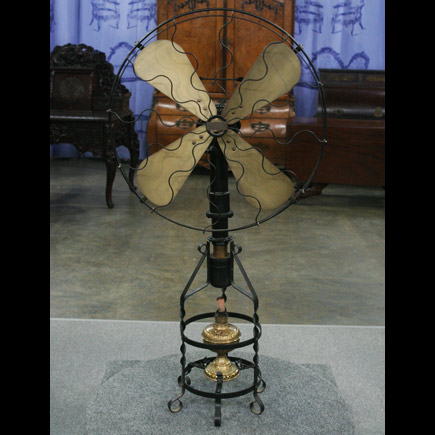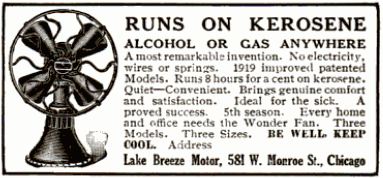Unplanned Obsolescence
Today, invention and obsolescence. The University of Houston's Department of History presents this series about the machines that make our civilization run, and the people whose ingenuity created them.
We've all heard of "planned obsolescence". Companies design products to have a limited useful life software made to be incompatible with other versions, lightbulbs that burn out quickly and must be replaced. But what about unplanned obsolescence? How do we think about machines that were intended to last, but didn't?
The question came to mind as I watched an episode of Antiques Roadshow. A guest brought in what looked at first like an old electric fan. But it wasn't; it was a Lake Breeze Motor Company Fan from around 1919. The top looks just like a standard electric fan. Look below, though, and we see something surprising: a kerosene lantern. Light the lantern, and it supplies a miniature hot air engine to drive the fan blades. Voila! A cool breeze.

It's a clever labor-saving device, moving the air without tiring human arms. Never mind that the lantern most likely warmed a room even as the fan tried to cool it, the concept is ingenious. And it really worked. The Lake Breeze Motor Company surely believed they had a modern, winning invention.
But timing is everything. This marvel of early 20th-century design came out just as electricity was becoming more common in American homes. The kerosene-powered fan soon became obsolete, undone by electricity. Why deal with the mess and fire danger of kerosene when you can have the same hands-free cooling, conveniently powered by new technology?
The Lake Breeze fan makes me a little wistful; its time was so short. So do other inventions that never quite succeeded, made obsolete shortly after they appeared. The Betamax video recorder, cutting edge when it came out, was soon overtaken by market forces and new technology. 8-track tape players, likewise. Our technology changes so fast, there may be many things that today seem new and exciting, but will be gone in a few years or even months.
A former professor of mine, Mark Kishlansky, once wrote, "History prefers the incipient to the vestigial." We like looking for the new direction, for "progress". Remnants of the old, like a fan driven by hot air, inspire only nostalgia, and maybe antiquarian curiosity.
But let's spare a thought for the also-rans, for the byways on the road to technological progress. The same creative forces drove the inventors of these quickly obsolete products as the makers of the machines that replaced them. They served their purpose, inspiring others to improve on them.
And perhaps they are not just objects of nostalgia. When the next hurricane knocks the power out for days, the "obsolete" Lake Breeze fan's off-the-grid cooling power might seem appealingly useful.
I'm Cathy Patterson at the University of Houston, where we're interested in the way inventive minds work.
(Theme music)
Sources:
The quote comes from Mark Kishlansky, Parliamentary Selection: Social and Political Choice in Early Modern England (New York: Cambridge University Press, 1986), p. 105.
PBS Antiques Roadshow website, "The Roadshow Archive: Lake Breeze Motor Company Fan, ca. 1919", accessed December 4, 2012. https://www.pbs.org/wgbh/roadshow/archive/200301A49.html.
Western Illinois Museum website, "Artifact of the Month, August 2012."
The ad image was taken from online version of Popular Science, ca July 1919.
John Lienhard examined the Lake Breeze fan in a rather different context in Episode 743.
This episode was first aired on January 7, 2013.
